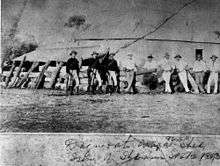1894 Australian shearers' strike

After the 1890 Australian maritime dispute and the 1891 Australian shearers' strike both of which were long, drawn out affairs in which trade unions were defeated, running out of funds, actions by increasingly militant and desperate unions led up to perhaps the most violent shearers' strike, in 1894.[2][3]
Pastoralists were motivated to cut rates and hire non-union labour (which was plentiful due to mass unemployment during the 1890s depression) by falling wool prices in London. The Amalgamated Workers Union rose to the defence of the shearers' wages in May 1894.
By October 1894 the Queensland Amalgamated Workers Union conceded defeat and called off the strike in the colony of Queensland. In NSW the strike continued, where possibly 16,000 workers gathered in strike camps. Police were mobilised against them.
The most famous incident of the strike was the sinking and burning of the steamer Rodney. The steamer was transporting non-union labour up the Darling. When the boat was moored in a swamp 23 miles above Pooncarie, a few miles above the Moorara shearing shed, unionists boarded, took control, offloaded all passengers, then soaked the hold in kerosine and set it alight. The burning boat drifted away and after several hours, sank.[3]
It has been widely accepted[4] Waltzing Matilda is probably based on the following story:
In September 1894, on Dagworth Station (northwest of Winton), some striking shearers fired their rifles and pistols in the air, setting fire to the woolshed. The owner of Dagworth Homestead and three policemen gave chase to a man named Samuel Hoffmeister – also known as "French(y)". Rather than be captured, Hoffmeister shot and killed himself at the Combo Waterhole.
References
- ↑ O'Keeffe, Dennis (2012). Waltzing Matilda: The Secret History of Australia's Favourite Song. Sydney: Allen and Unwin. ISBN 978-1-74237-706-3.
- ↑ A History of Queensland by Raymond Evans, Cambridge University Press, 2007 ISBN 978-0-521-87692-6)
- 1 2 Armstrong, Mick Burning the Rodney
- ↑ National Library of Australia, Robyn Holmes (2011-06-07). "National Library of Australia "The Creation"". Nla.gov.au. Retrieved 2013-01-07.